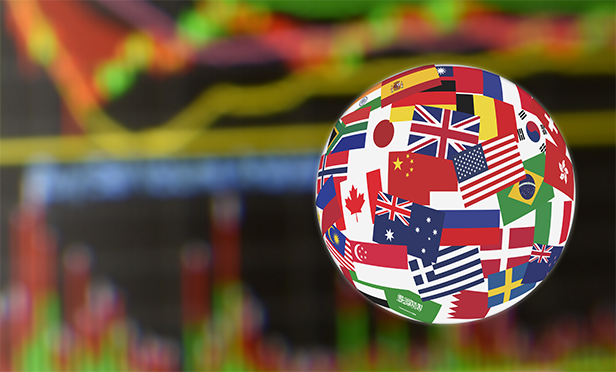
The global economy faces some serious headwinds this year, coming in the form of trade policy uncertainty, oil price volatility, monetary policy missteps by major players, and the economic slowdown in China. These headwinds are expected to cause turbulence for many countries, but especially for emerging markets.
All that said, some emerging markets remain fertile for business opportunities. According to a recent report from trade credit insurer Atradius, the most promising emerging markets in 2019 are Bulgaria, Indonesia, Vietnam, Peru, and Morocco. Indonesia, Vietnam, and Morocco also appeared on our 2018 list of promising emerging markets.
To be considered “promising,” a market must demonstrate steady, accelerating growth in gross domestic product (GDP) fueled by private consumption and fixed investment. It must also show resiliency against global headwinds in the form of sufficient external buffers and a flexible exchange rate. Increasing trade diversification is a positive indicator, as are the presence of dynamic domestic markets, particularly in manufacturing, infrastructure, and more consumer-oriented sectors—and a broad and growing middle class.
Additional factors that mark an economy as promising include:
- Less red tape. Too much bureaucratic oversight can sink a business, so the ease of operating in a market is an important indicator of its future growth. Promising markets have relatively accommodating business environments or are taking steps to improve the ease with which foreign companies can do business.
- Lower geopolitical risk. This always makes a country a safer bet, but it's an even stronger indicator now that uncertainty is high in the global market. To determine whether a country's political situation is stable, or the likelihood that the government will negatively interfere with economic growth, Atradius analysts use the STAR rating system, which was created by the Atradius Economic Research Team for assessing country risk, including political and economic risks, civil unrest, and conflict.
Bulgaria: A Standout in Eastern Europe
While most of Eastern Europe is facing difficulties stemming from Russian economic sanctions and the Turkish recession, Bulgaria's economy is expected to grow 3.5 percent in 2019, up from 3.3 percent in 2018. Strong domestic demand and fixed investment contribute to this positive outlook. Additionally, household incomes are increasing and domestic interest rates are low, while import demand is on the rise. Export opportunities are plentiful in the consumer durables and food-and-beverage sectors.
Bulgaria also benefits from the current European Union (EU) budget cycle. EU subsidies are aiding the machinery sector, which saw a year-over-year increase of more 13 percent from January to September 2018. Other sectors benefit from EU subsidies as well, including the green energy, chemicals, and agriculture industries. Agriculture has long been one of Bulgaria's strongest sectors, and it's expected to continue growing this year, increasing demand for fertilizer imports.
Vietnam: Resilient Against Chinese Slowdown
Emerging Asia overall has a strong outlook, even against the backdrop of the slowdown in China. Vietnam is particularly promising, with forecasts of 6.7 percent GDP growth through the end of this year. Vietnam's economy is oriented toward highly diversified exports, with export growth outpacing GDP growth. Additional positive indicators include high wage growth, expanding private consumption, and government policies aimed at increasing business investment.
Vietnam's population of more than 95 million, along with a quickly growing middle class, is fueling strong import demand for foreign goods, especially food-and-beverage products. An uptick in infrastructure and construction is also driving high demand for fuel across the transportation, aviation, and residential sectors.
Vietnam's highly open economy exposes it to U.S.–China tensions, but it could also benefit from those countries' trade disputes. The United Nations Conference on Trade and Development estimates Vietnam could see a 5 percent gain in exports if additional Chinese tariffs are put in place. The country's sizable textiles industry, in particular, could grow as much as 15 percent with support by the EU-Vietnam free-trade agreement and the new Comprehensive and Progressive Agreement for Trans-Pacific Partnership (CPTPP).
Indonesia: High Demand Across Many Sectors
Like Vietnam, Indonesia is proving resilient against the slowdown in China, with GDP growth forecasted to reach 5.1 percent in 2019. The country enjoys a history of solid growth, aided by a stable political situation, strong fundamentals, and economywide buffers against headwinds. Private consumption growth is high, thanks to rising incomes, rising employment, and increased public spending.
Demand is high, and opportunities abound for foreign companies in the food-and-beverage, e-commerce, packaging, manufacturing, and consumer durables sectors. The petrochemicals and fertilizer sectors are also looking rosy. The government has undertaken large-scale renewable energy projects, which is driving demand for infrastructure. The machinery sector is predicted to see import growth, as well, driven by high construction activity for electricity and transport development.
Morocco: Tourism and Green Energy
Although the Middle East and North Africa are expected to see a slight slowdown in growth this year, Morocco bucks the trend, with GDP growth predicted to increase to 3.3 percent in 2019, compared with the 2.8 percent growth experienced in 2018. This positive outlook is based in part on Morocco's uptick in agricultural production and increase in non-agricultural growth, including manufacturing, which has recently seen more government investment. Morocco's political situation is also stable and will likely remain so for the next few years.
Morocco's position as a strategic hub for trade and investment between Europe and Africa, and between North America and the Middle East, means high growth potential for the export-oriented manufacturing sector. Tourism is another traditionally strong sector—tourism has grown 6 percent, on average, since 2000, with 8.5 percent growth in 2018. Food-and-beverage products and services benefit from this trend.
The renewable energy sector is another one of Morocco's strengths and offers opportunities for imports. More than one-third of Morocco's power comes from renewables, with concentrated solar power leading the pack. The government plans to continue investing in this area to reach its target of 42 percent renewable energy by next year.
Peru: Stability in South America
Political volatility and economic slowdowns are increasing uncertainty across Latin America, but Peru's stability and growth rate of 4 percent—high for the region—make it a standout. The country is pro-business, with business-friendly policymaking, investment-grade sovereign credit ratings, strong institutions, and a sound external environment. Rising incomes and high consumer confidence are feeding demand in the food-and-beverage and consumer durables sectors.
Peru's primary industry sectors—anchovy fishing and hydrocarbon production—are expected to drive growth this year. Private companies are currently developing new mines, which marks an increase in private-sector investment. Export opportunities are supported by Peru's liberal trade stance. The country has established trade agreements with multiple markets, including the United States, the EU, China, Australia, and Mercosur (a trade bloc consisting of Argentina, Brazil, Paraguay, and Uruguay). Peru is also a member of the Trans-Pacific CPTPP trade agreement.
These five countries that we have labeled “most promising” are not necessarily the fastest-growing countries in the world. They do, however, offer stable or accelerating growth, friendly business conditions, and abundant growth opportunities across a diverse group of sectors. The consumer durables and food-and-beverage industries, in particular, stand out in these countries as strategic opportunities for firms wanting to expand to a new market.
 Dana Bodnar is an economist at Atradius, where she is responsible for macroeconomic and country risk analysis specializing in Central and Eastern Europe.
Dana Bodnar is an economist at Atradius, where she is responsible for macroeconomic and country risk analysis specializing in Central and Eastern Europe.
© Touchpoint Markets, All Rights Reserved. Request academic re-use from www.copyright.com. All other uses, submit a request to [email protected]. For more inforrmation visit Asset & Logo Licensing.



